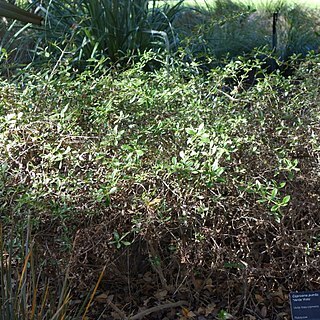Stems prostrate, creeping and rooting, up to c. 6 dm. long, ± monoec.; branches with dark brown to greyish bark; branchlets slender, glab. Lvs often fascicled, on petioles 1-3 mm. long; stipules triangular, subacute, ciliolate. Lamina coriac. to subfleshy, glab., elliptic to obovate-elliptic, (3)-4-10 × (1)-4 mm., obtuse to subacute, narrowed into winged petiole; margins entire. Midrib alone evident below, impressed above. ♂ solitary, terminal; bracts stipulate, small, calyx-teeth acute; corolla-tube narrowly funnelform, lobes acute; stamens 4-3.♀ solitary, terminal; calyx-teeth acuminate; corolla tubular, lobes acute, style-branches (2)-3-4. Drupe globose, red, 6-10 mm. diam., pyrenes 2-4.
More
A small matted shrub which grows along the ground. It spreads 30-100 cm wide. It roots at the nodes. The leaves are 0.5-1 cm long and 0.2-0.3 cm wide. They are shiny. Male and female flowers are on separate plants. The flowers are about 0.8 cm long. They occur singly at the ends of short branches. They are green. The fruit is fleshy with a hard stone inside and is 0.6-0.8 cm wide. It is orange or red.
It is a temperate plant. It grows in subalpine places above 500 m altitude. It requires cool, moist conditions. It needs rich, well drained soil. Tasmania Herbarium.
More
Higher montane to sub-alpine grassland, North, South and Stewart Islands.

